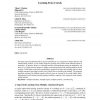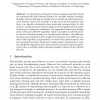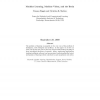TCAD
2010
14 years 2 months ago
2010
- This paper presents a supervised learning based power management framework for a multi-processor system, where a power manager (PM) learns to predict the system performance state...
JMLR
2010
14 years 2 months ago
2010
For many supervised learning tasks it may be infeasible (or very expensive) to obtain objective and reliable labels. Instead, we can collect subjective (possibly noisy) labels fro...
JMLR
2010
14 years 2 months ago
2010
Estimating the error rates of classifiers or regression models is a fundamental task in machine learning which has thus far been studied exclusively using supervised learning tech...
Publication
For quantitative analysis of histopathological images,
such as the lymphoma grading systems, quantification of
features is usually carried out on single cells before categorizing...
PRL
2011
14 years 2 months ago
2011
: This paper addresses the inference of probabilistic classification models using weakly supervised learning. The main contribution of this work is the development of learning meth...
HAIS
2010
Springer
14 years 5 months ago
2010
Springer
In this article, we describe a feature selection algorithm which can automatically find relevant features for multiple instance learning. Multiple instance learning is considered a...
COLT
2010
Springer
14 years 5 months ago
2010
Springer
We explore the relationship between a natural notion of unsupervised learning studied by Kearns et al. (STOC '94), which we call here "learning to create" (LTC), an...
IJON
2008
14 years 5 months ago
2008
The problem of inductive supervised learning is discussed in this paper within the context of multi-objective (MOBJ) optimization. The smoothness-based apparent (effective) comple...
ML
2002
ACM
14 years 7 months ago
2002
ACM
We present a general approach to model selection and regularization that exploits unlabeled data to adaptively control hypothesis complexity in supervised learning tasks. The idea ...
AIM
1999
14 years 7 months ago
1999
The problem of learning is arguably at the very core of the problem of intelligence, both biological and artificial. In this paper we review our work over the last ten years in th...



